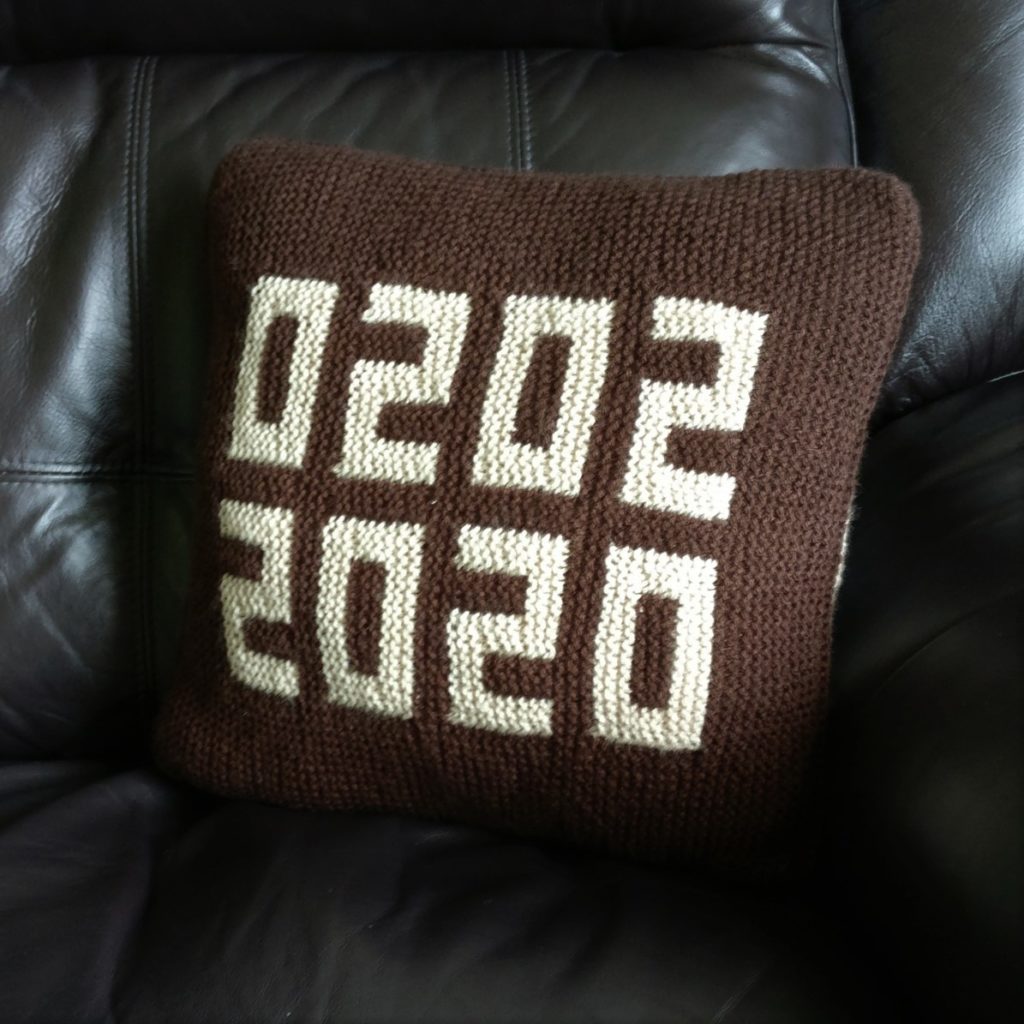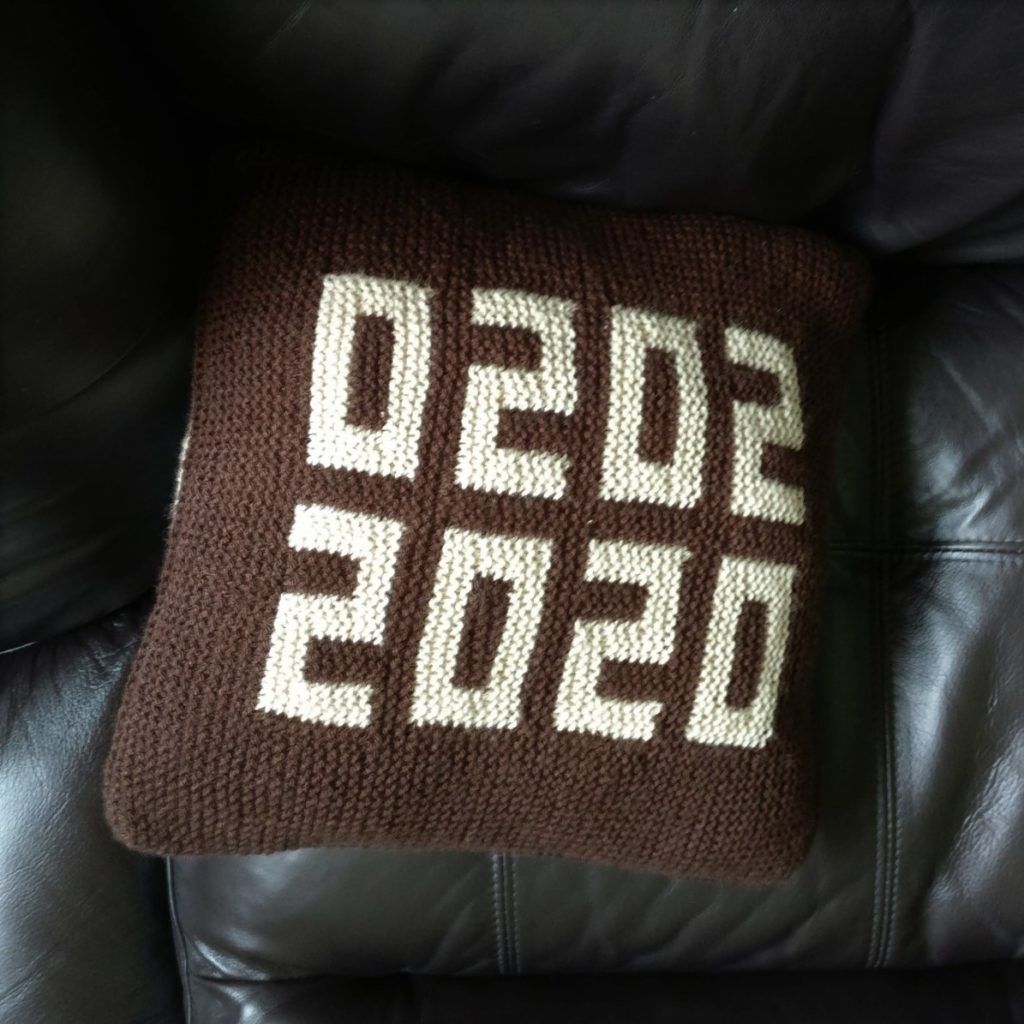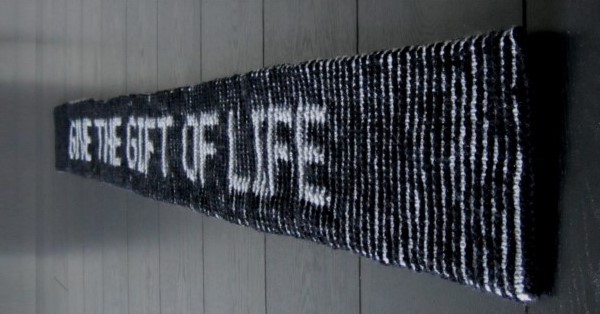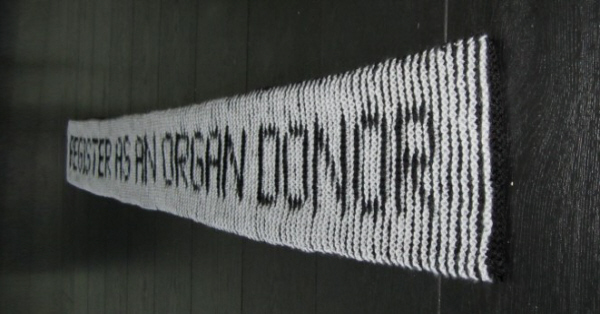Today is 02/02/2020. Whichever side of the Atlantic you are this is a palindromic date. It doesn’t matter whether you put day or month first, or whether you put them before or after the year, they read the same backwards as they do forwards. What’s more the date will also read the same if you turn it upside down.
As a mathematician I find those numbers very pleasing but this date is remarkable for other reasons.
On this day my kidney transplant is 33.33 years old. That’s a third of a century! Coincidentally it is also Ben’s birthday and I made him a cushion. (It is also Groundhog Day and Candlemas.)
The cushion looks exactly the same when you turn it upside down.


I fundraise for Kidney Research and here are the reasons why.
My kidney has never functioned spectacularly well but it has plodded along and kept me alive, and living a fairly normal life, for all these years, thanks to some unknown person who was generous enough to donate their loved one’s organs in 1986.
I have Polycystic Kidney Disease. My father had PKD. My grandmother, who died, in 1929, almost certainly had PKD.
When my father, George Boddy, was diagnosed in 1963 little was known about PKD. Despite living in Staffordshire, he became a patient of the Royal Free Hospital, London, which was one of the very few hospitals with experience of the disease. By 1966 he was on dialysis. This was in the early days of home dialysis when all patients had to be within easy reach of the hospital. George had joined the Household Cavalry as soon as he was old enough. He served for many years, including the whole of World War 2. When he left he became a police officer. He was very determined and disciplined and, combined with his DIY skills, this made him the ideal person to trial dialysis 150 miles from base. He was never afraid to try something new and was a willing volunteer to try out any new techniques.
Both of my parents became involved in educating others about dialysis, which was a very unfamiliar procedure, even to many medical people. They did this through talks and demonstrations, sometimes using a series of slides, which can be seen on the Woolly Thoughts web site. George and Maisie made a big contribution to the development of the home dialysis system.
George had an unsuccessful transplant in 1969. In the last few years before his death he was no longer able to be a ‘bobby on the beat’ but his astounding local knowledge was put to good use as Collator of Information for the local Police Force. He was still a serving police officer when he died in 1974. (Maisie also died from another kidney disease many years later.)
My progress was monitored over the years. By 1983, I was, to all outward appearances, living a normal life and working as a teacher in a very demanding school but I had amazingly little kidney function. I was put on a ‘low clearance’ diet and watched very closely, to try to determine why my body didn’t seem to accept what was happening. My condition continued to decline but I still did not feel any ill effects. After three years on the diet it was decided that it was dangerous to continue any longer without dialysis.
I started on dialysis and very soon afterwards, to everyone’s surprise, a kidney became available for transplant. I am from one of the rarer blood groups. I consider that I was very lucky to be ‘in the right place at the right time’. The kidney was not a good match. In those days it was thought to be important that there should be a close match. I was as good a match as anyone else they had on the list, and I was already in hospital though not really unwell, so it was decided to take a risk. It was definitely a gamble but it added to research that was being carried out.
The first few months were very shaky. I was in hospital for seven weeks. During that time I had peritonitis, which didn’t help. There was no suitable drug that could be used so I agreed to taking one that was still in trials. It worked like magic. I believe it saved my life. I had to fill in an enormous questionnaire afterwards. I don’t know whether it ever became an approved drug but I was glad to have been part of the testing.
I agreed to take part in many trials over the years. One of the early ones was to compare the effects of Cyclosporin with Azathioprine. Cyclosporin was the new wonder drug but it was found to be poisoning my kidney and I had to be withdrawn from that trial. I still take Azathioprine and Prednisolone now. They are the kind of drugs you have to take forever to prevent the immune system from rejecting the transplanted kidney, which it regards as a foreign body.
Eventually the kidney settled down. It has never produced the stunning results that many transplantees have but it is almost as good now, thirty-three and a third years later, as it was then. For the past fourteen years I have been able to see all my test results online via an amazing service which was originally known as Renal Patient View and is now Patient View. I cannot praise this system highly enough. This is the NHS at its very best. I can have my blood taken at my local surgery in the morning and see my results at midnight the same day. This means I can make minor adjustments to some of my medication, if necessary, without having to go to the hospital or take up a doctor’s time. It is good for all sides.
My results on Patient View go back to 2006 and my highest ever eGFR is 25. eGFR stands for Estimated Glomerular Filtration Rate and is an indication of kidney function. Anything above 60 is considered to be normal. The good thing is that it has stayed fairly stable although it is now below 20.
I hadn’t felt ill before the transplant but I felt a million times better afterwards. A progressive disease creeps up so slowly you don’t notice it. I am eternally grateful to the family who gave their loved one’s organs for transplantation. I know that four kidneys were given that night, and I believe that they were all the same blood group which makes me think that they were probably from two members of the same family.
Unlike most transplant patients I still need to limit the amount of liquid I consume (but, thankfully, not as drastically as dialysis patients do). My kidney doesn’t seem to work fast enough to process it but that is a small price to pay.
Over the years I have been looked at by more students than I could possibly count. I have signed to allow my details to be shared for various purposes. I have been a patient for doctors’ exams and in the training of doctors for those exams. I have been videoed for training purposes. Whenever possible I have agreed to whatever I have been asked to do. It is all part of the research that goes on all the time.
There have been good times and bad times. Immunosuppressants mean that transplant patients can get some weird and wonderful things that don’t happen to ‘normal’ people and I have had my share.
My illness has changed my life dramatically and taken me down paths I could never have imagined. I am a knitter. I have been a knitter for as long as I remember. I have also done many other crafts but knitting was always something to return to in the times when sitting around and waiting. After the transplant I lost much of the feeling in my fingers and they never quite returned to how they were before. It was frustrating and I had to find a way round. For a long time I couldn’t use more than one yarn at a time because I couldn’t feel what I was holding. So how could I make multi-coloured things. The first trick, which I learned from a famous knitter, was to make a ball of different lengths tied together and knit as though it was just a normal ball. That worked OK but I was not in control of the result.
The mathematician in me came to the fore and I started making small geometric shapes and then adding on more and more pieces, only using one ball at a time. To cut short a long story, this eventually developed into writing several books and creating mathematical wall-hangings. My husband and I designed these, getting inspiration from each other. We became very well-known in the knitting, and maths education communities. Some of our earliest pieces were bought by the Science Museum in London. Knitting was the unconventional medium we used to teach maths. We travelled this country and abroad, sometimes working with high-powered mathematicians, sometimes with small children, sometimes with groups of ‘I can’t do maths’ ladies.
We have taught in a palace in Italy, above the snow-line on a volcano in New Zealand, at a football stadium event with 10,000 children, and many other amazing places. None of this would have happened if it hadn’t been for the drugs I have taken all this time. Yes, they leave me vulnerable to various types of cancer and strange illnesses, they have wasted my muscles, they make my skin unbelievably fragile, but I am still here! I have a large bald patch as the result of surgery on my skull but I have ten wigs in a variety of colours. It confuses people a bit sometimes though. I can be a different person every day and I have saved a fortune on hairdressing bills.
Since we reached retirement age we have gone off on another tack and are now equally famous for designing and creating illusion knits. These look very complex but are really very simple. They rely on knitting two rows in one colour, followed by two rows in another colour and, although I am much slower than I used to be, I can do that. We don’t travel any more but the internet means that we can communicate with people who we can’t teach in person. Without my illness none of these things would have happened. We are happiest when we hear of the effects we have had on other people. I never expected to live to be over seventy years old or to become involved with such a wide range of amazing people. If we have brought light into any of their lives, my transplant has done far more than benefitting me.
A transplant is a treatment, not a cure. There are always side effects. Nobody could have known what the long term effects of some of the treatments might be but the research that has gone on over that time has helped to refine the treatment still further and make the prospects better for anyone needing treatment in the future. I have seen, first-hand, the progress over more than 50 years and it has been dramatic.
We have also been involved with The Little Yellow Duck Project. It’s aim is to raise awareness of the need for blood, bone marrow, organ and tissue donors. Hand-made little ducks, with labels round their necks, are left for people to find. The ducks can be logged on a world map and the site also has links to the donation registers in many countries. Ducks have been reported from over one hundred countries.
If you want to try your hand at illusion knitting we designed a scarf that looks normal from straight in front but, when you look from an angle it says GIVE THE GIFT OF LIFE on one side and REGISTER AS AN ORGAN DONOR on the other. You can download the pattern


Fascinating. Thank you for sharing this.
You are an amazing and generous human being. Thank you for sharing your thoughts and story with your life.